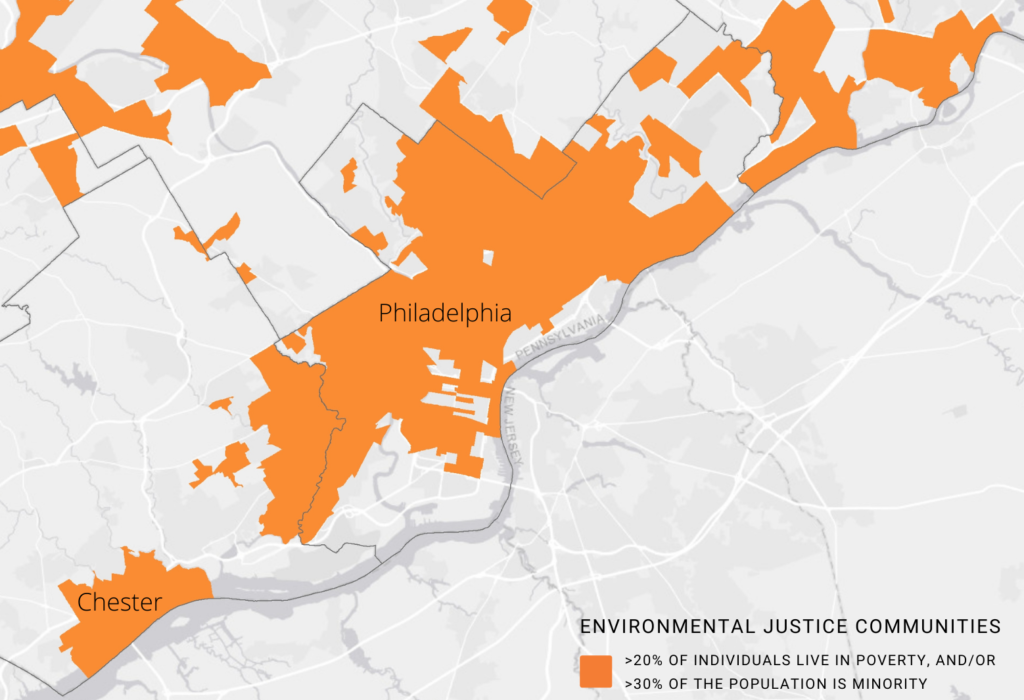Environmental Issues
Philadelphia high school students lead a protest demanding climate change solutions, 2019.
How will climate change affect Philly?
Due to climate change, our city of Philadelphia is expected to be hotter, wetter, and snowier. By 2050, Philadelphia temperatures are expected to be more comparable to current Richmond, Virginia's temperatures. As natural disasters will continue to be more frequent and more severe, this means Philadelphia transportation will be less and less reliable. As flooding becomes more and more common and sea-levels rise, there are chances that FDR Park and the Philadelphia Airport will be underwater by 2100.
Economically, Philadelphia could suffer as tourism decreases from destruction and decay of historical sites and transit from increased flooding and extreme weather events. This also increases needs for transit maintenance, which could increase taxes as well. Philadelphia will also experience more heat waves and poorer air quality, which will worsen respiratory illnesses, asthma, and water-borne illnesses from floods.
The Schuylkill River Trail flooded due to extreme weather, in December 2020.
How will climate change affect Pennsylvania?
Climate change has affected Philadelphia in many ways, and will continue to affect it more and more. Philadelphia already has high rates of land being converted into development (ranked 5th in the country), and this has led to the loss of forests, fragmented natural habitats, and urban sprawl. Inefficient transportation systems, longer commutes into cities, and increased non-point source pollution have all led to increased greenhouse gas emissions. Due to climate change, all of these problems will only increase. Pennsylvania as a state can expect warmer and wetter temperatures.
Economically, climate change will affect Pennsylvania in many ways, including:
Decreased tourism and recreational activities
Warmer winters will impact skiing seasons and ice skating on natural bodies of waters
Hotter summers will worsen ground level ozone pollution in urban areas, thus discouraging urban tourism, muting fall foliage colors, halting water-related recreational activities, and increasing the frequency and intensity of floods and droughts.
Threatening jobs related to biodiversity in PA
Biodiversity - variety of species, their genetic makeup, and the natural communities in which they occur
Threatened by climate change
Biodiversity plays a major role in the Pennsylvania economy
90,000 jobs in 2,500 firms are from the forest products industry in PA, with $4.5 billion contributed to the economy
1996 - $1.8 billion to PA economy from activities associated with watching, feeding, or photographing wildlife
20% of Philadelphians hunt, trap or fish, and spend $1 billion annually
In total - economy in PA is greatly dependent on its biodiversity, which is being threatened
Projected Annual Changes in U.S. Annual Average Temperatures, for 21st Century.
What can you do? Resources to help, who to vote for, organizations to join:
VOTE for green initiatives and issues!
Philly Initiatives:
https://whyy.org/articles/opinion-earth-day-philadelphia-city-government-climate-change/
https://billypenn.com/2021/08/24/climate-change-philadelphia-tips-carbon-footprint-vegan-emissions/
Philly Organizations to join/look at:
Local Philadelphians rally against climate change, 2019.
Environmental Justice Issues in Philadelphia:
Environmental justice is defined by the US Environmental Protection Agency as “the fair treatment and meaningful involvement of all people regardless of race, color, national origin, or income, with respect to the development, implementation, and enforcement of environmental laws, regulations, and policies''. While climate change will continue to affect Philadelphia, it will continue to affect different areas and people unproportionally.
The Pennsylvania Department of Environmental Protection identified over 1,000 environmental justice areas in the state, of which at least 20% of the population lives in poverty and 30% are non-white minorities. Various contaminant concerns of environmental justice in the state include lead contamination in water and paint, air pollution, extreme weather, and health concerns from hydraulic fracturing.
About 21% of children in Philadelphia have asthma, which is higher than the national rate and Philadelphia is one of the 25 worst metropolitan areas for ozone and year round particle pollution in the nation. However, minority communities are disproportionately burdened by pollution and the negative health consequences resulting from it. Air pollution from industrial sites is the main cause of worsening air quality, meaning that the communities that live nearby such polluting sites are primarily affected. These communities tend to be poorer and consist of higher minority populations, and thus suffer from higher rates of asthma, and various types of cancer.
Environmental Justice Communities within Philadelphia.
However, action to combat environmental injustice has been taken recently in Philadelphia. Councilmember Helen Gym implemented the Community Health Act in February of 2022. This requires the Department of Public Health to develop an environmental justice map that shows communities that have exposure to toxins and unsafe chemicals from their proximity to industrial sites. It also requires the city of Philadelphia to use this map when granting a permit for any industrial siting, activity or operation that could harm public health. Lastly, it gives the Department of Public Health power to mandate mitigation measures before a project takes place. This map has been linked below. At the same time, Philadelphia instituted a Environmental Justice Advisory Commission, and an Interagency Working Group on Environmental Justice. This established a community resilience and environmental justice grant fund for the cause of environmental justice.
Although environmental justice continues to be a prevalent issue in Philadelphia and Pennsylvania, these steps are important in making change. The continuation of such efforts are necessary. To support or learn more about environmental justice issues, check out some of the links below.
https://whyy.org/articles/philadelphia-new-environmental-justice-solutions-grant-funding/
https://whyy.org/articles/philly-environmental-justice-advisory-commission-members/
Climate and Economic Justice Screening Tool:
https://screeningtool.geoplatform.gov/en/#14.17/39.95746/-75.18879
Sources:
By Ava Bybee, April 2023
Updated December 2023




